#294 Latest Comet Hyakutake images: April 08, 1996
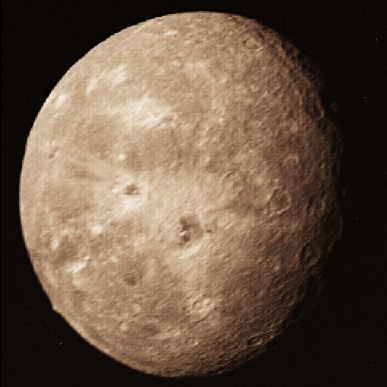
“Oberon is the most distant and second largest moon of Uranus. Discovered by William Herschel in 1787, the properties of the world remained relatively unknown until the robot spacecraft Voyager 2 passed it during its flyby of Uranus in January 1986. Compared to Uranus' moons Ariel, Titania, and Miranda, Oberon is heavily cratered, and in this way resembles Umbriel. Like all of Uranus' large moons, Oberon is composed of roughly half ice and half rock. Note that Oberon has at least one large mountain, visible on the limb at the lower left, that rises 6 km off the surface. Latest Comet Hyakutake images: APOD Hyakutake Archive, JPL, Fayetteville Observer-Times, NASA's Night of the Comet, ICSTARS, Jerry Lodriguss, ScienceWeb, Crni Vrh Obs., Cent. Mich. U."
Copyright: Public domain
#295 Information: April 09, 1996
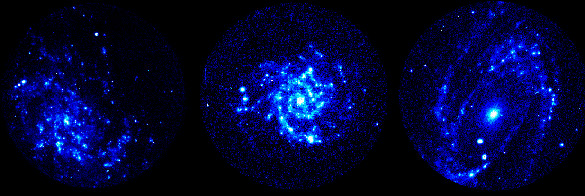
“A progression of beautiful spiral galaxies is illustrated above with three photographs from NASA's Ultraviolet Imaging Telescope (UIT). Flying above the Earth's obscuring layer of atmosphere on the Space Shuttle Columbia during the Astro-1 mission in 1990, UIT's cameras were able to image these distant spirals in the ultraviolet light produced by hot, young stars. These bright stars, newly condensed from gas and dust clouds, give away the location of the spiral arms they are born in. Because they are massive (many times the mass of the Sun), they are shortlived. Dying and fading before they move too far from their birth place they make excellent tracers of spiral structure. From left to right the galaxies are known as M33, M74, and M81 and have progressively more tightly wound spiral arms. Astronomers would classify these as Scd, Sc, and Sb type spirals using a galaxy classification scheme first worked out by Edwin Hubble. Information: The Scale of the Universe Debate in April 1996"
Copyright: Public domain
#296 Information: April 10, 1996
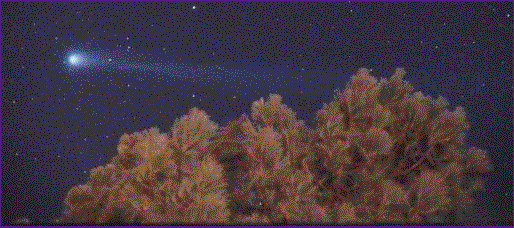
“Comet Hyakutake is still visible as it continues its orbit around the Sun. The comet will brighten again in late April and early May. The above fascinating picture was taken with a three minute exposure. In the middle of the exposure, the photographer cleverly set off a flash, momentarily illuminating the foreground tree. The picture was taken on March 24th from Mount Teide in the Canary Islands, and the recorded tail length was over 50 degrees. Discoverer Yuji Hyakutake, whose last name means "100 warriors" is an amateur astronomer in Japan. Interested in comets since age 15, he discovered this comet while sitting on a rural mountain top searching dark skies with huge binoculars in early morning hours. Originally intending to check up on a comet he had discovered only one month earlier, Hyakutake was initially worried that the new fuzzy spot he had located was not really yet another comet! One unexpected result of his comet discovery is that now his family has trouble making phone calls because their telephone is always ringing. Information: The Scale of the Universe Debate in April 1996"
Copyright: The Astronomer Online
#297 Information: April 11, 1996
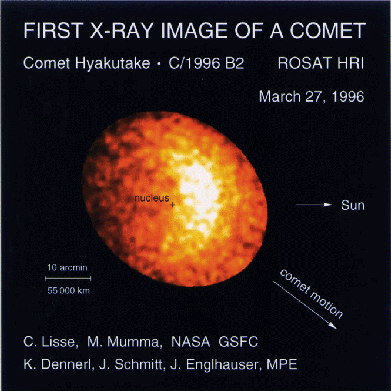
“The first X-rays ever detected from a comet were discovered from Comet Hyakutake with the ROSAT satellite on March 27th. The discovery is particularly surprising because there was little previous indication that comets emit any significant X-radiation. As the comet passed the Earth in late March, repeated observations with ROSAT also showed that the X-ray brightness changed over just a few hours. The crescent shape of the X-ray emission is also enigmatic. One possible explanation is that X-rays emitted from the Sun are absorbed by water in the comet's coma causing fluorescence. Another possible explanation involves interaction with the solar wind - fast moving particles streaming away from the Sun. Information: The Scale of the Universe Debate in April 1996"
Copyright: Public domain
#298 Information: April 12, 1996

“Thirty five years ago today, Soviet cosmonaut Yuri Alexseyevich Gagarin became the first human in space. On April 12, 1961, his remotely controlled Vostok 1 spacecraft lofted him to an altitude of 200 miles and carried him once around planet Earth. Strictly a passenger, his onboard controls were locked out by a secret combination - in case of emergency he carried the combination in a sealed envelope. After reentry, Gagarin ejected from the Vostok at an altitude of 20,000 feet and parachuted to Earth. How was the first view from space? He reportedly commented, "The sky is very dark; the Earth is bluish. Everything is seen very clearly". Coupled with other spacefaring accomplishments, this flight seemed to confirm Soviet technological superiority - the first US astronaut would not be launched until almost a month later and then on a comparatively short suborbital flight. Born on March 9, 1934, Gagarin was an air force jet pilot before being chosen for the first group of cosmonauts in 1960. As a result of his historic flight he became an international hero and legend. Killed when his MIG jet crashed during a training flight on March 27, 1968, Gagarin was given a hero's funeral, his ashes interred in the Kremlin Wall. Information: The Scale of the Universe Debate in April 1996"
Copyright: Public domain
#299 Information: April 13, 1996
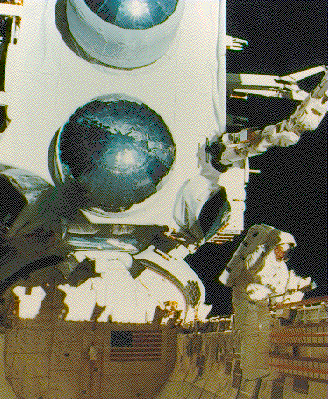
“rlier this April, NASA's Compton Gamma Ray Observatory, completed its fifth successful year in orbit, exploring the gamma ray sky. Pictured is astronaut Jay Apt perched in the shuttle payload bay below the massive observatory. Compton is the largest civilian instrument ever flown - the whole observatory is roughly the size of a school bus. Apt and colleague Jerry Ross rescued the spacecraft from an unexpected problem by successfully freeing the stuck high gain antenna in an unplanned space walk. The second of NASA's planned Great Observatories for Space Astrophysics, the first being the Hubble Space Telescope, the Compton Gamma Ray Observatory has exceeded expectations of scientific discovery. Compton continues to search the depths of the universe for such high energy phenomena as gamma-ray bursts, blazars, and pulsars. Compton is still monitoring a new source it discovered just last December - the spectacular "bursting pulsar" near the center of our Galaxy. Information: The Scale of the Universe Debate in April 1996"
Copyright: Public domain
#300 Information: April 14, 1996
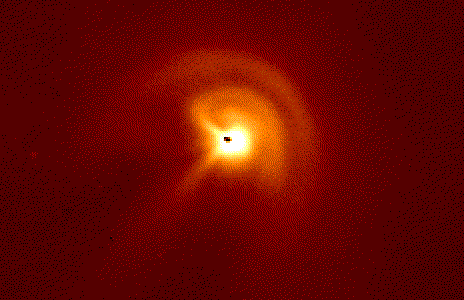
“Comet Hyakutake will reach its closest point to the Sun on May 1, passing well inside the orbit of Mercury. At this time, the comet's dust and ion tail will be at their greatest physical length. As the comet nears the Sun, gas and dust are driven off the surface, sometimes being shot off in jets. Although much of this material ends up in the tail, some interesting features can be seen close to the comet's three kilometer nucleus. Because the comet's nucleus rotates, the jets can be seen to form arcs around the comet's center resembling a pinwheel. The above photograph, taken April 8, shows two expanding arcs of cometary material and two source jets. The outermost arc is at a projected distance of 12,000 kilometers from the nucleus. The inner is about 8,000 kilometers from the nucleus. They are expanding from the nucleus at 870 km per hour. The inner arc ends at the brightest of the Comet Hyakutake's many jets. Information: The Scale of the Universe Debate in April 1996"
Copyright: Public domain
#301 Information: April 15, 1996
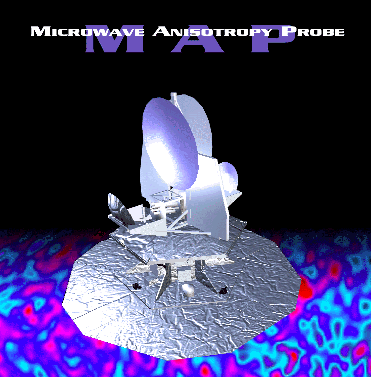
“What is our universe made of? How rapidly is our universe expanding? When did galaxies form? These questions, among the most important and baffling to astronomers since the beginning of the modern astronomical era, might well be answered by a new space satellite mission. The Microwave Anisotropy Probe (MAP) is being designed inspect the universe's microwave background radiation in more detail then ever before. MAP will record the frequency, size and temperature of bumps 20 times smaller than COBE. Astronomers have computed what bumps would be expected from several models of our universe, and comparing these results to MAP's data may yield a new understanding of the composition and structure of our universe. MAP has just won approval as a NASA MIDEX class satellite, and is currently scheduled to launch in the year 2000. Information: The Scale of the Universe Debate in April 1996"
Copyright: Public domain
#302 Information: April 16, 1996
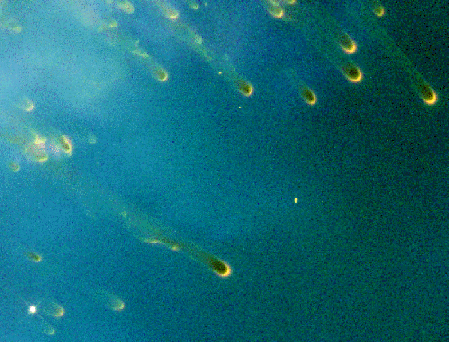
“Four hundred fifty light-years from Earth, the wind from a dying, sun-like star produced a planetary nebula popularly known as the Helix. While exploring the Helix's gaseous envelope with the Hubble Space Telescope (HST), astronomers discovered indications of 1,000s of striking "cometary knots" like those shown above. So called because of their resemblence to comets, they are actually much larger - their heads are several billion miles across (roughly twice the size of the our solar system itself) while their tails, pointing radially away from the central star, stretch over 100 billion miles. Previously known from ground based observations, the sheer number of cometary knots found in this single nebula is astonishing. What caused them to form? Hot, fast moving shells of nebular gas overrunning cooler, denser, slower shells ejected by the star during an earlier expansion may produce these droplet-like condensations as the two shells intermix and fragment. An intriguing possibility is that instead of dissipating over time, these objects, could collapse and form pluto-like bodies. If so, these icy worlds created near the end of a star's life, would be numerous in our galaxy. Information: The Scale of the Universe Debate in April 1996"
Copyright: Public domain
Upvote! Resteem! Comment! As you like it! Thank you for attention!
Thanks to me for a such wonderful post!!! :)